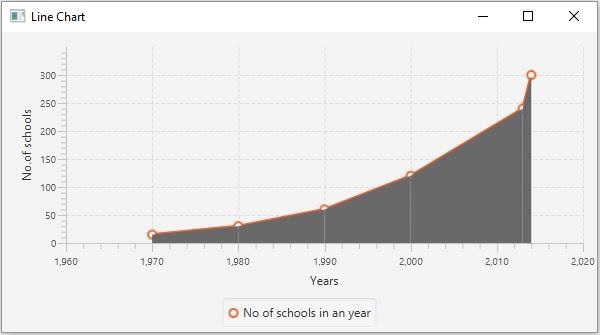
 Data Structure
Data Structure Networking
Networking RDBMS
RDBMS Operating System
Operating System Java
Java MS Excel
MS Excel iOS
iOS HTML
HTML CSS
CSS Android
Android Python
Python C Programming
C Programming C++
C++ C#
C# MongoDB
MongoDB MySQL
MySQL Javascript
Javascript PHP
PHP
- Selected Reading
- UPSC IAS Exams Notes
- Developer's Best Practices
- Questions and Answers
- Effective Resume Writing
- HR Interview Questions
- Computer Glossary
- Who is Who
How to color the plotted area of a JavaFX xy-chart?
All the XY charts have an abstract method named layoutPlotChildren(). To color the plotted area (region) of an XY chart one way is to override this method. Generally, it is called to update and layout the plot of children.
In the body of this method −
Get the series data.
Extract the plotted points.
Draw a polygon in the plotted area using the extracted points.
Set the desired color to the polygon.
Example
import javafx.application.Application;
import javafx.collections.FXCollections;
import javafx.collections.ObservableList;
import javafx.scene.Scene;
import javafx.stage.Stage;
import javafx.scene.chart.LineChart;
import javafx.scene.chart.NumberAxis;
import javafx.scene.chart.XYChart;
import javafx.scene.chart.XYChart.Series;
import javafx.scene.layout.StackPane;
import javafx.scene.paint.Color;
import javafx.scene.shape.Polygon;
public class EnhancingGraphPlot extends Application {
public void start(Stage stage) {
//Defining the x axis
NumberAxis xAxis = new NumberAxis(1960, 2020, 10);
xAxis.setLabel("Years");
//Defining the y axis
NumberAxis yAxis = new NumberAxis (0, 350, 50);
yAxis.setLabel("No.of schools");
//Preparing the data for the X-Y chart
XYChart.Series<Number,Number> series = new XYChart.Series<Number,Number>();
series.setName("No of schools in an year");
series.getData().add(new XYChart.Data<Number,Number>(1970, 15));
series.getData().add(new XYChart.Data<Number,Number>(1980, 30));
series.getData().add(new XYChart.Data<Number,Number>(1990, 60));
series.getData().add(new XYChart.Data<Number,Number>(2000, 120));
series.getData().add(new XYChart.Data<Number,Number>(2013, 240));
series.getData().add(new XYChart.Data<Number,Number>(2014, 300));
//Creating data
ObservableList<Series<Number, Number>> data =
FXCollections.observableArrayList(series);
//Creating the Line chart
LineChart<Number,Number> lineChart = new LineChart<Number,Number>(xAxis, yAxis, data ) {
//Overriding the layoutPlotChildren method
protected void layoutPlotChildren() {
super.layoutPlotChildren();
Series<Number,Number> series = (Series<Number,Number>)
getData().get(0);
ObservableList<Data<Number,Number>> listOfData = series.getData();
for(int i = 0; i < listOfData.size()-1; i++) {
double x1 = getXAxis().getDisplayPosition(listOfData.get(i).getXValue());
double y1 = getYAxis().getDisplayPosition(0);
double x2 = getXAxis().getDisplayPosition(listOfData.get((i + 1)).getXValue());
double y2 = getYAxis().getDisplayPosition(0);
Polygon polygon = new Polygon();
polygon.getPoints().addAll(new Double[]{
x1,y1, x1, getYAxis().getDisplayPosition(listOfData.get(i).getYValue()), x2,getYAxis().getDisplayPosition(listOfData.get((i+1)).getYValue()), x2,y2
});
getPlotChildren().add(polygon);
polygon.toFront();
polygon.setFill(Color.DIMGRAY);
}
}
};
//Adding the line chart to stack pane
StackPane pane = new StackPane(lineChart);
//Setting the scene
Scene scene = new Scene(pane, 595, 300);
stage.setTitle("Line Chart");
stage.setScene(scene);
stage.show();
}
public static void main(String args[]){
launch(args);
}
}
Output


Advertisements
